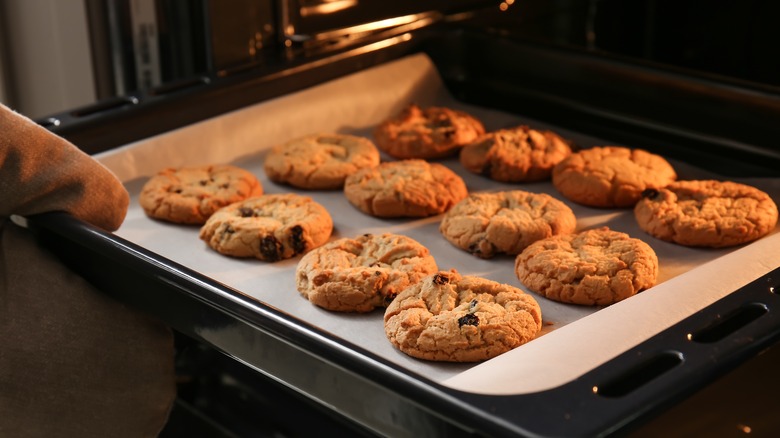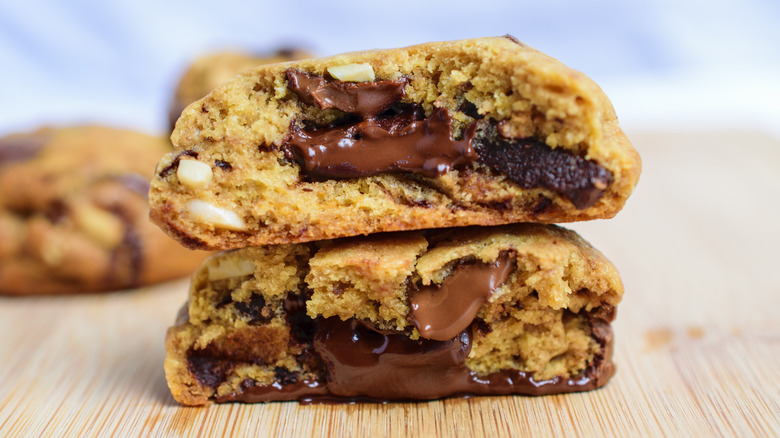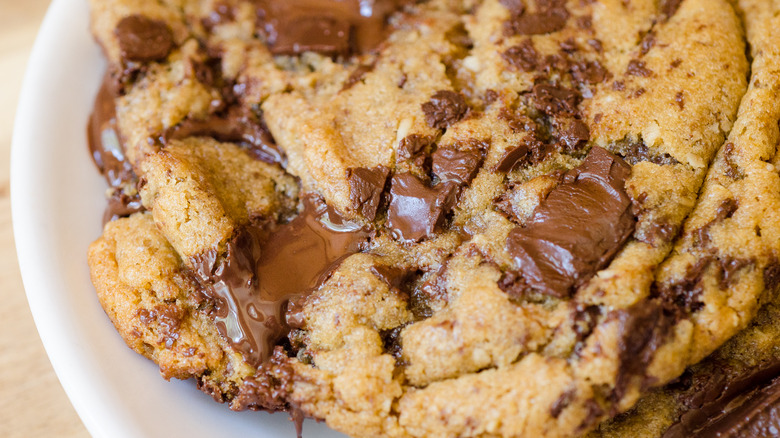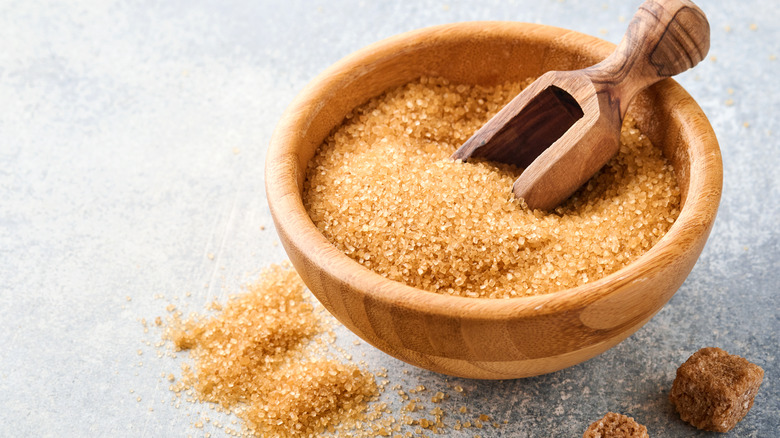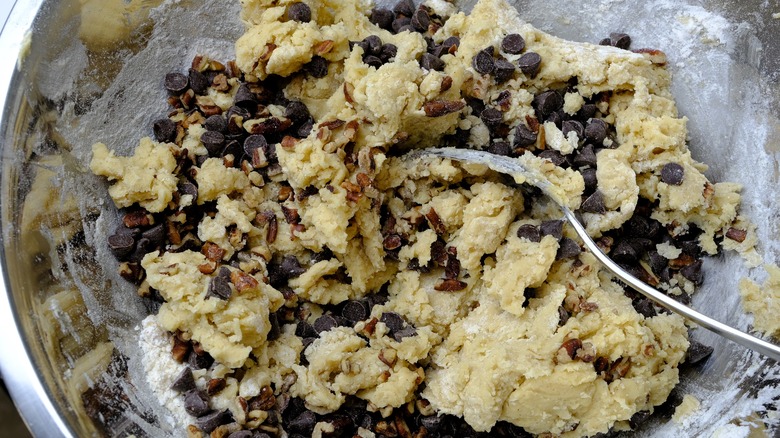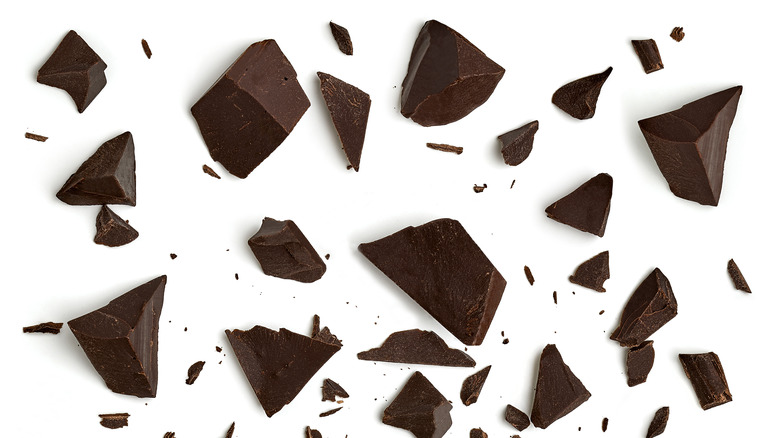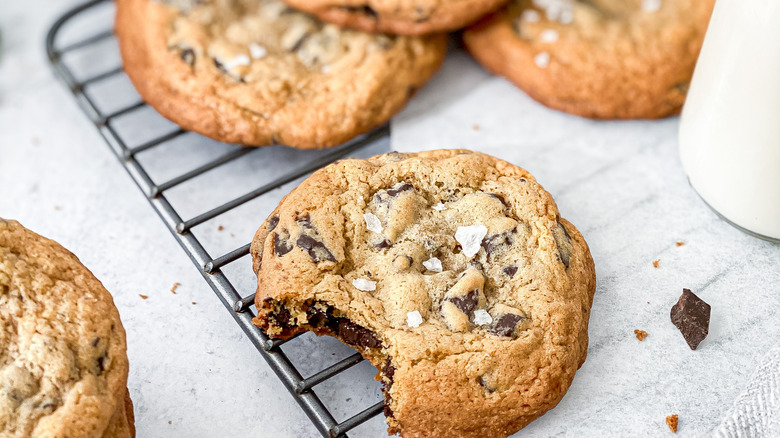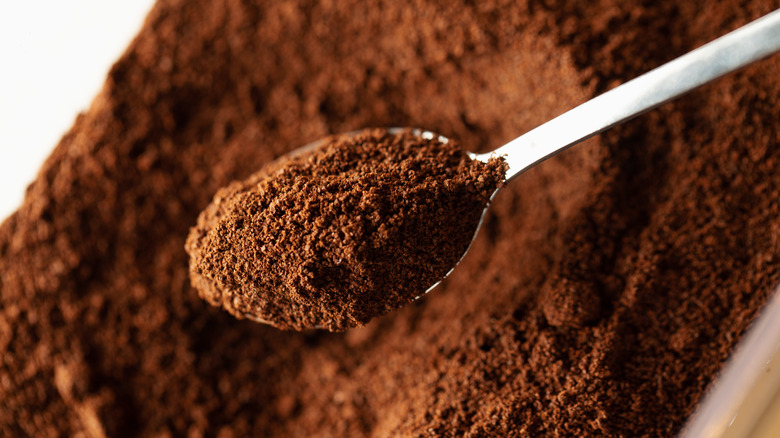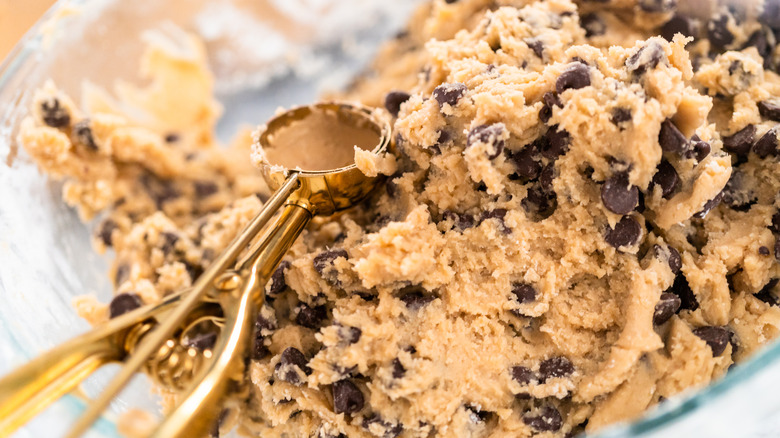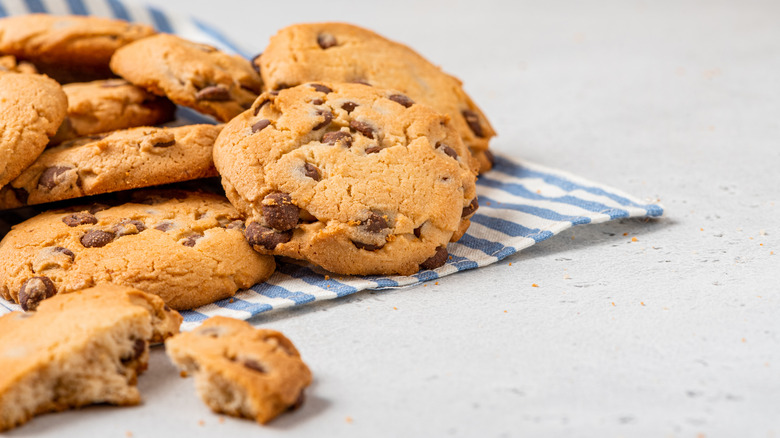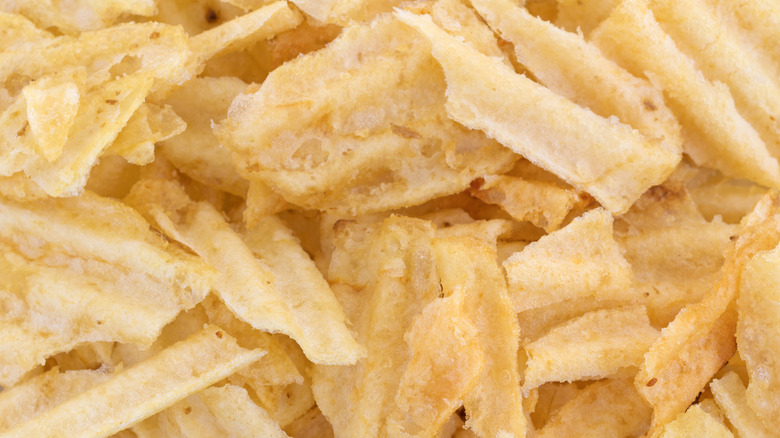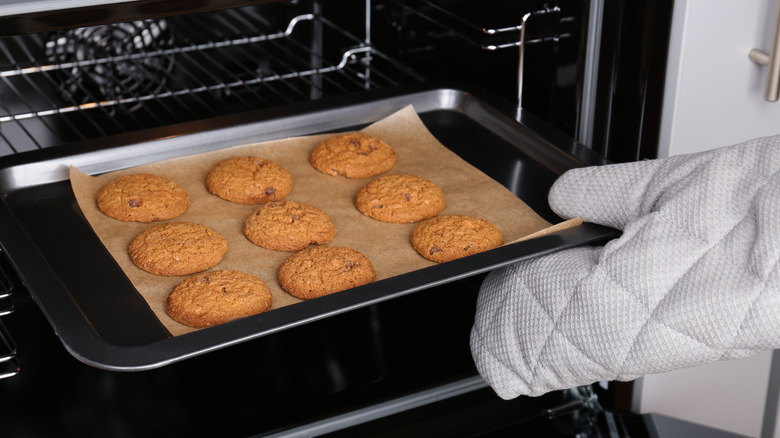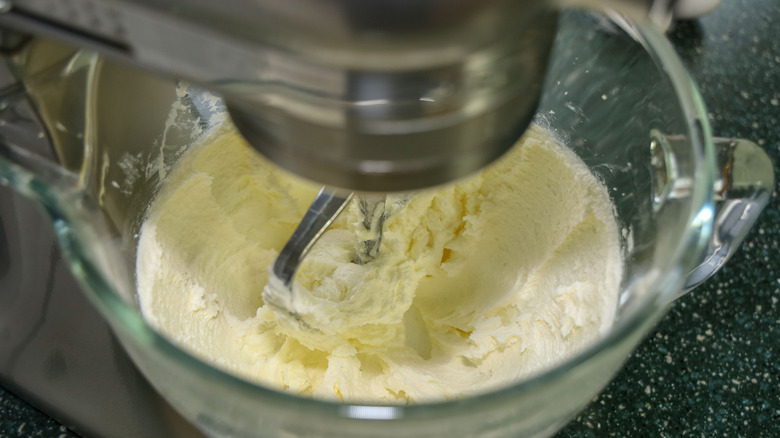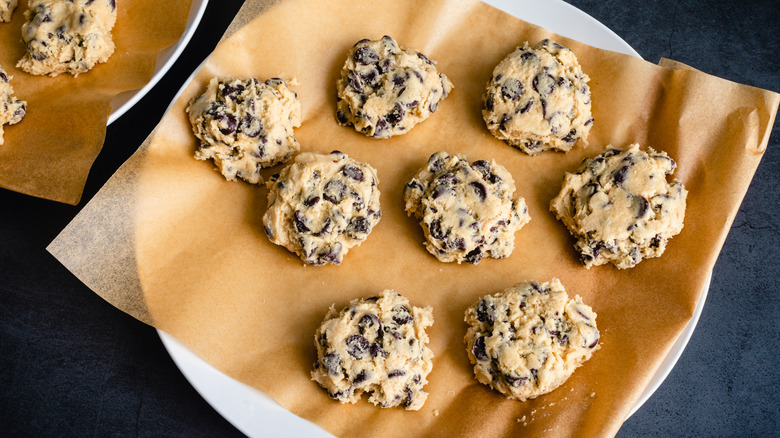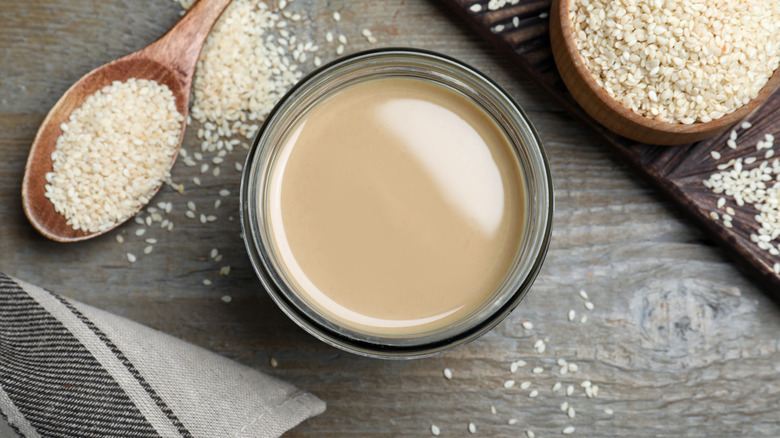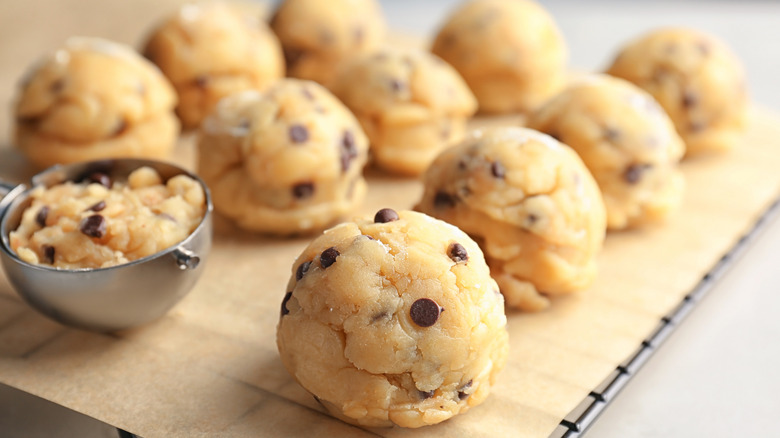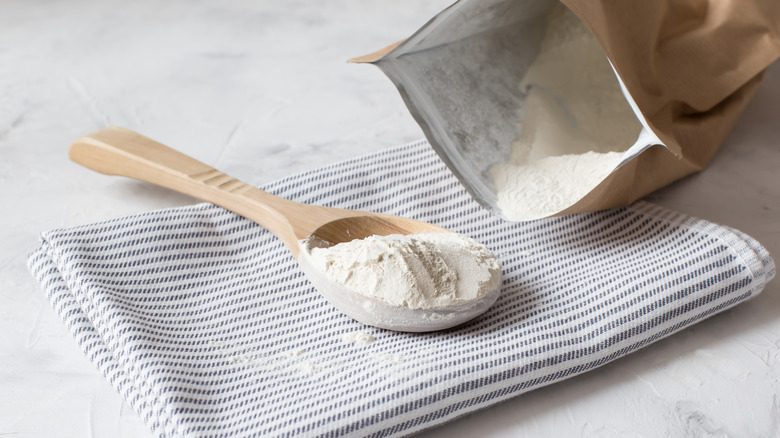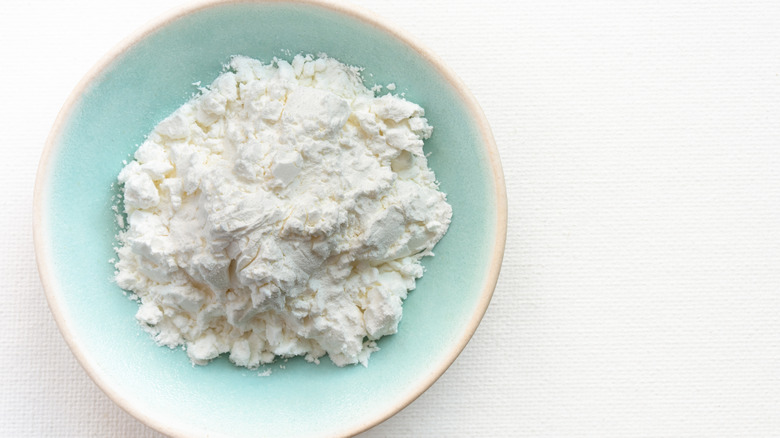17 Tips You Need For Making The Ultimate Chocolate Chip Cookie
America's favorite cookie is undoubtedly the classic chocolate chip. These delicious, blissful cookies were initially invented by Ruth Wakefield, operator of the Toll House Inn in Whitman, Massachusetts. The cookie made its way into her 1938 recipe book, entitled "Tried and True," where it was believed to have originally been an accompaniment for ice cream. Although the chocolate chip cookie has come leaps and bounds in the past 80 years, the standard recipe remains the same: butter, eggs, flour, salt, sugar, leavening agents, and, of course, those chocolate morsels.
There's more to the chocolate chip cookie than just these ingredients, though. A little creativity and a whole lot of patience can help you make genuinely terrific chocolate chip cookies at home. We've consulted several cookie experts in our quest to craft the perfect chocolate chip cookie. We compiled their advice on ingredients, methodology, and techniques to help home bakers improve their cookie game. Here are some of the tips you need to make the ultimate chocolate chip cookie.
Add instant pudding for soft cookies
Soft chocolate chip cookies are melt-in-your-mouth, plush, and dense cookies. This type of cookie stays more round (and puck-like) during baking and does not flatten like a crispy or chewy chocolate chip cookie. If you crave these kinds of cookies, you should elevate your chocolate chip recipe with one simple addition: instant pudding mix. The instant pudding keeps the dough soft and translates to a cookie with a cakey texture and soft quality.
Adding instant pudding mix to your cookie recipe opens up the opportunity to mix and match different flavors, including banana, vanilla, and chocolate. Pour the dried pudding mix into your batter with the rest of the dry ingredients; you won't have to prepare your pudding mix ahead of time. You'll need a single small box (3.4 ounces) per batch of cookies. Be sure only to use the instant pudding mix rather than the cook-and-serve variety.
Include brown butter for a toasty, toffee undercurrent
While the recipe for chocolate chip cookies may be simple, you can use different ingredients to develop complexity in flavors and textures. One ingredient that will make your chocolate chip cookies more flavorful is brown butter. Brown butter is made by toasting the milk solids until they turn nutty and brown in color. Luckily, this step will only take you an additional 20 minutes — which is totally worth it for flavorful cookies.
To make your brown butter chocolate chip cookies, melt ¾ cup unsalted butter in a skillet over medium-low heat. Since the cooking will evaporate some of the water, you'll need to use slightly more butter than if you were to add it right into the dough. Cook the brown butter until the brown flecks start to appear. Then, cool your butter for about fifteen minutes before adding in your sugar and proceeding with your cookie recipe. You'll be rewarded with a delicious nutty, toffee flavor.
Add more sugar for a crunchy cookie
To understand how to make a crunchy cookie, we have to break down the science a little bit. Sugars are considered hygroscopic, which means it attracts and retains the liquid in the dough. In turn, the sugar will absorb the liquid that would otherwise cause the gluten in the cookie to develop. As a result, a cookie with a high gluten development is chewy, while cookies with low gluten development tend to be crispier.
Chef Dave Dreifus, co-owner of Best Damn Cookies, recommends adding a little more sugar to the cookie dough for a crunchy cookie. Elisa Marshall, the owner of New York City's Maman, also recommends rolling the cookie balls in some raw sugar before baking. Raw sugars, like Turbinado, remain crystalized longer than granulated sugar and can add texture to the cookie's outside. Marshall notes that it is critical to roll the dough balls in sugar after chilling the dough, as this will prevent the sugar from being absorbed by the cookie.
Always use fresh nuts in your cookies
One of the most common additions to chocolate chip cookies is nuts. Elisa Marshall recommends using raw nuts for cookies rather than those that have already been roasted and salted. "Whenever we add nuts to our chocolate chip cookies, we always use raw, unsalted nuts because it tends to have a better flavor and a little more crunch than roasted nuts. And sometimes, of course, roasted nuts tend to extract the oils and can really change the flavor profile of the nut itself... we feel like the flavor of the raw nut doesn't overpower the cookie and really just helps add the crunch and texture to it."
Chef Dave Dreifus emulates a similar tone. "Buy great ingredients and treat them well. Bad nuts equal bad cookies." He recommends storing nuts in the freezer to prevent the cookies from becoming rancid quickly. Be sure to sample a few nuts before adding them to the dough to ensure they are fresh.
Use baking wafers instead of chocolate chips
One of Elisa Marshall's tips for a great chocolate chip cookie is substituting chocolate chips with chocolate wafers. "The key to using the wafers, and why we use the wafers as opposed to the chips is that they have more cocoa butter, which gives them a higher melting point... you're going to get that ooey-gooey chocolate." The chips instead tend to keep their shape and result in a more crunchy chocolate component.
If you don't have wafers readily available, Marshall recommends chopping up a baking bar or using chips with a higher cocoa butter composition. Marshall likes classic chocolate chip cookies with 72% cacao chocolate wafer. She notes that this chocolate tends to have a "nice sharpness" that less pungent chocolate tends not to have. Marshall shares that milkier chocolates tend to have a sweeter flavor profile — which is overpowered by the sweetness of the dough.
Add salt to accentuate the flavors in your cookie
Although salt is considered a savory seasoning, it is a critical component of baking many sweet recipes. Salt intensifies the body's ability to taste the sweetness and enhances the flavors of ingredients that would otherwise be lost — like vanilla extract. Salt also can distract from the sickeningly sweet flavor of the cookie and transport the flavors into a new dimension. You should always use the standard ½ teaspoon recommended in most cookie recipes because, as Chef Dave Dreifus shares, "salt enhances the flavor of everything, so let it touch everything."
While a properly seasoned chocolate chip cookie may not need to up the ante with a sprinkle of salt on the outside of the cookie after baking, Elisa Marshall recommends it. She uses flaky sea salt for her cookies to help enhance the flavors. She suggests adding a sprinkle immediately after baking to prevent the cookies from absorbing it.
Espresso powder enhances the chocolate flavor in your cookie
Chocolate is obviously a critical component of the chocolate chip cookie. But the secret ingredient you need to help amplify your chocolate flavors is a little more unconventional. Chef Dave Dreifus suggests adding a little bit of espresso powder to the cookie to help boost the taste of the chocolate.
Espresso powder is a strongly flavored powder made from concentrated coffee crystals. It has a much darker flavor than the instant coffee you'd add to a hot cup of water in the morning, so it is used sparingly in brownies, cakes, and even dry rubs for meat to amplify flavors. You won't have to worry about making your chocolate chip cookies taste like coffee cookies either — using less than a teaspoon will boost the chocolate flavors and add some complexity to your cookies. While you can use plain instant coffee as a replacement for espresso powder, you won't get the same intense flavor.
Avoid over-handing your cookies
One of the biggest mistakes people make with cookie dough is over-handling it, Elisa Marshall explains. "Once we put [the dough] in the KitchenAid or stand mixer, we don't want to, especially working with wafers, because they are more melting wafers and kind of have a higher breaking point and aren't as solid as chocolate chips, they can tend to break up and melt into your dough really easily." If you over-mix the cookie dough, you may find that the chocolate tends to infuse back into the dough and not remain a distinguishable component.
To prevent overmixing, Marshall recommends mixing in your chocolate with a light hand to avoid breaking them into pieces. Adding your chocolate in last, as well as keeping the dough chilled, will prevent it from becoming streaky and will keep those chocolatey pieces gooey. Over-mixing is also important to avoid in building the fundamental structure of the dough because it can cause the gluten to set and the cookies to become too dense.
Play with your leavening agents for a cakier cookie
Cakier cookies tend to have a softer crumb structure and a little more volume than other cookies. You feel like you're biting into a blondie rather than a cookie. To create this structure, both Elisa Marshall and Chef Dave Dreifus recommend playing with leavening agents — like baking soda, baking powder, and eggs — to help create a lighter, fluffier cookie. Cakey chocolate chip cookies tend also to have more flour in the batter, which promotes a rise more like a cake than a cookie. In addition, bakers who specialize in making cakey cookies tend to beat a lot of air into the dough using a stand mixer — which promotes a higher rise and more structure.
Thick cakey cookies, like the Levain Bakery style, use a lower ratio of sugar than the flour in the cookie (remember that sugar causes the cookies to absorb moisture). This will prevent the cookies from spreading once they hit the sheet.
Experiment with adding textures and seasonings for a unique cookie
Chocolate chip cookies don't have to include just chocolate chips. Elisa Marshall is a proponent of playing with different flavors and textures in cookies, including her most recent chocolate chip cookie recipe with crushed salt and vinegar kettle chips. She used a standard chocolate chip cookie base before adding in the crushed kettle chips. Before baking, Marshall also rolled each cookie ball in crushed salt and vinegar chips. "It was a really unique flavor combination... the tartness and the crunch in it helped to retain some cool texture in the cookie."
Marshall has also experimented with other creative add-ins to chocolate chip cookies, including the addition of fresh chopped rosemary and a sprinkle of sea salt. "Chocolate pairs very nicely with herbs," she explains. Other popular chocolate chip cookie pairings include cayenne pepper, which provides an undercurrent of warmth to the cookie.
Bake round cookies in a convection oven
All ovens are unique, which in turn makes baking an exploratory process and one that has us scratching our heads. Elisa Marshall explains that recipes typically vary on the exact cooking time because ovens have different power levels that will impact every batch of cookies differently. "I find convection ovens tend to create a flatter, crispier cookie," Marshall shares. This is because the convection oven circulates heat around the entire oven, dramatically speeding up the bake time and producing a brown cookie in much less time than a standard oven. If you're baking in a convection oven, you should lower the recommended cooking temperature by 25 degrees Fahrenheit to account for the faster bake time.
Not only do convection ovens produce a crispier cookie, but they can also help counteract the impact of baking with multiple pans. If you're using a standard oven, the cookies on the racks closest to the heating element tend to brown the fastest, while the pans in the middle of the oven come out underbaked. A convection setting ensures a more even browning across all trays.
Always cream the butter and sugar together first
If your dreamy chocolate chip cookie is soft and plush rather than dense and stodgy, you will want to highlight one crucial step in your recipe: creaming the butter and the sugar. This simple step is vital for the best chocolate chip cookies ever because it ensures that you are beating air into the mixture. When the butter is whipped at high speeds, small air pockets form in it. This air is then maintained in the batter up until baking.
The best method to cream your butter is to always start with room temperature butter — since it's easier to whip. Then, start your stand mixer at a low speed. Once your butter is super fluffy, you can add in your sugar and beat it at a higher speed. We've also found that beating the sugar into the butter means it's better incorporated and a little less gritty than if you were to add it with the rest of the dry ingredients.
Don't neglect chilling your dough
Elisa Marshall shares one of her most significant and essential steps for making a great chocolate chip cookie: chilling the dough. "When you ball the cookies and roll the dough, the heat, friction, and temperature from your hands can really regulate the turnout of the cookie. We played around and tested just putting a ball [of dough] that's been refrigerated for two hours directly on the sheet, and that tends to result in a higher cookie that's more crispy on the outside and retains its rounded shape." In comparison, the cookies that went from the bowl straight to the sheet tended to flatten and crunch more.
Chilling your dough also has numerous benefits for the texture and flavor of the cookie. Letting cookie dough rest helps them taste better because some of the moisture is removed when the dough is in the fridge. The enzymes in the flour also start to break down and yield a better browning. In addition, the chilling of the dough helps re-solidify some of the butter, resulting in a cookie with a more rounded shape.
Use tahini for a vegan cookie
One common theme we noticed among our interviewees was the inclusion of tahini as an ingredient for vegan cookies. Tahini is a smooth paste made from sesame seeds; it has a slightly thinner texture than peanut butter with a less pronounced flavor. Therefore, adding it to cookies won't impact the taste of the cookie too much — but it will result in a soft, creamy, and decadent cookie that you probably wouldn't be able to tell was vegan.
Our recipe for chocolate chip cookies with tahini is made with almond flour, so they have a nutty undertone amplified by the tahini's nuanced flavor. Some recipes use the tahini as an egg replacement, but it should be noted that these recipes won't produce the same vertical rise as a cookie leavened with eggs (in addition to the leavening agents). You should also use unsalted, smooth tahini for the best textural result.
Cookie scoops achieve the same size cookies across batches
One of baker Claire Ptak's best tips for home bakers is to use a cookie scoop to portion out cookie dough balls before baking. In an exclusive interview with us, she shared that this method has several benefits in improving both the efficiency and presentation of her cookies. You'll get cookies that are all the same size — and you won't have to worry about getting cookie dough all over your fingers when scooping from batch to batch.
You can purchase many different sizes of scoops depending on your cookie needs. Ptak's go-to scoops are the ice cream scoops; they produce massive, bakery-style cookies. This tool is a good investment if you're making cookies regularly, but it can be substituted with two spoons if you only venture for the occasional chocolate chip cookie fix, and not the regular one like we do.
Incorporate xanthan gum for gluten-free cookies
Gluten-free baking is no small feat, and finding out how to make cookies without using flour can always be a challenge. Kafi Dublin, the owner of New York City's Gooey on the Inside, recommends partnering up with xanthan gum to make a gluten-free chocolate chip cookie that holds together well. She notes that this ingredient is essential because it "helps bind together the ingredients, preventing your cookies from falling to pieces." Xanthan gum is used as a stabilizer in many gluten-free products, where it can provide a similar elasticity and strength as gluten would.
Dublin also notes that one of the keys to making a tremendous gluten-free chocolate chip cookie is to allow the dough to rest for at least 30 minutes before baking. She notes that this window of time allows the gluten-free flour to adequately hydrate, which in turn promoted a gluten-free cookie that sticks together while baking.
Add cornstarch for a softer cookie
One of Kafi Dublin's other secret ingredients for baking cookies is cornstarch. You may not have ever heard of this gravy and sauce thickening ingredient used for cookies, but it performs a similar function in your favorite cookie dough. Dublin notes that this powdered additive helps promote softness and thickness in cookie dough. Bakers may mix cornstarch with other flour to help promote a soft, chewy cookie rather than a hard, crunchy cookie.
Cornstarch is a pantry staple that you should always have on hand, but there are some substitutes that you can use if you don't have a container readily available. Potato starch can be used as a 1-to-1 replacement for cornstarch, but it tends to clump up much more. Arrowroot starch is the most comparable alternative; it will leave your cookies with a distinct shine that cornstarch also elicits.
Static Media owns and operates Tasting Table and Mashed.
